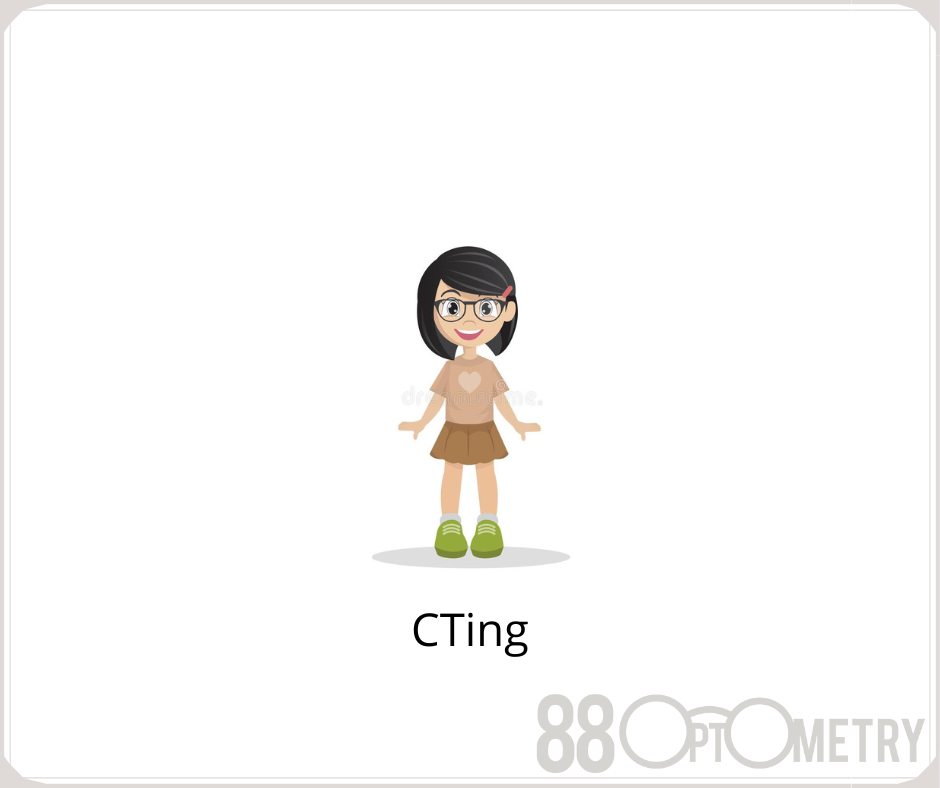CTing (F/10) came for follow up, vision with existing glasses made with us is slightly blurry at far.. near vision is fine. We gave her a separate pair for near previously (due to esophoric eye posture @Near) but she did not use the near glasses. No headache is reported.
Vision without glasses
R: 6/30
L: 6/24-
Vision with existing glasses
R: -0.50 (6/18-)
L: -0.75 (6/9-)
Examination shows:
R: -1.25/-0.25×5 (6/6) [+1.00 blur lens test: 6/9-]
L: -1.00/-0.50×170 (6/6) [+1 .00 blur lens test: 6/12-] (L: left dominant eye) L>R
Add: +0.75 R>L
Lowering shortsightedness 0.25 binocularly is not favoured
Other assessments show:
Examination of Eye Alignment/Vergence (Cover Test, CT)
NMD @Distance
(alternating CT: upon covering left eye, patient reported the target goes to her right.. when covering right eye, the target goes to her left)
small EP, fast recovery @Near
(alternating CT: upon covering left eye, patient reported the target goes to her right.. when covering right eye, the target goes to her left)
(normal value: orthophoria/NMD-No Movement Detected or small XP, fast recovery)
EP = Esophoria is misalignment of the eye, eye is deviated inwards
XP = Exophoria is misalignment of the eye, eye is deviated outwards
Examination of Eye Alignment/Posture (Howell Card) by 6^ Base Down on Right eye
Distance: 1 EP (yellow part)
Near: 1 – 3 EP (yellow part)
+1.00 Near: 2 XP (blue part)
-1.00 Near: 11 EP (yellow part)
(normal value: 0-1 EP (yellow part) or 0-3 XP (blue part) @Distance; and 0-6 XP (blue part) @Near)
EP = Esophoria is misalignment of the eye, eye is deviated inwards
XP = Exophoria is misalignment of the eye, eye is deviated outwards
NRA (Accommodation analysis – ability to relax accommodation) by plus lens
+2.00
(normal value: +1.50 to +2.50)
PRA (Accommodation analysis – ability to stimulate accommodation) by minus lens
-0.75
(normal value: -1.37 to -3.37)
NPC (Convergence – ability of eye to maintain a single clear near image) by RAF rule
8/10cm, 8/10cm, 8/10cm
(normal value: Break/Recovery in less than 10cm or to the nose, TTN)
Facility (Accommodation facility – ability to change focus: far to near or near to far) by Flipper +/- 2.00
BE: 10 cycle per minit(cpm), difficult with minus lens(2nd lens)
R: 12 cycle per minit(cpm), difficult with minus lens(2nd lens) (right eye sees better than with both eyes)
L: 8 cycle per minit(cpm), difficult with minus lens(2nd lens) (both eyes see better than with left eye)
(normal value: 1 cycle = 2 words read
Monocular or R/L: 6cpm to 16cpm
Binocular or BE-both eyes: 4cpm to 14cpm)
MEM – Monocular Estimation Method (Accommodation lag – to measure accommodation response seeing near target)
R: +0.50
L: +0.50 (sometimes PL)
(normal value: +0.25 to +0.75)
AA (Amplitude Accommodation/Focusing – eye stamina/ability of eye to focus & sustain seeing near clearly) by RAF rule
R: 10 YO, 10 YO, 10 YO (target is blurry @end of RAF rule, only comes into focus @30cm) (target is better with astigmatism)
L: 10 YO, 10 YO, 10 YO (target is blurry @end of RAF rule, only comes into focus @30cm) (target is better with astigmatism)
(normal value: AA goes according to age; YO=years old)
Fusional Reserves (Convergent/Divergent reserve stamina) by Prism Bar
Near, Base-In/Divergent, NFV: 6/10/6
Near, Base-Out/Convergent, PFV: x/8/6
Distance, Base-In/Divergent, NFV: x/4/2
Distance, Base-Out/Convergent, PFV: x/14/12
(normal value: Blur/Break/Recovery)
Near, PFV: 10-28/7-21
Near, NFV: 7-19/5-15
Distance, PFV: 4-18/5-9
Distance, NFV: 4-10/2-6
[Scheiman et al – Adult Data]
Vergence Facility – ability to make rapid repetitive vergence changes (by Prism Flipper of 12Base Out & 3Base In)
Near: 5 cpm (double with Base In)
Distance: 10 cpm (initially double with Base Out, then no more double)
(normal value: 1 cycle = 2 times clearing target
Distance: 12-18 cpm
Near: 12-18 cpm)
We tried with 1BD OU/1BO OU, but she did not like it.
Interpupillary distance, IPD = 5.9cm
KIV BIFR training prism flipper

